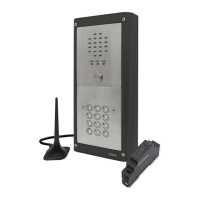66250675-EN - V1.0 - 05/09/17
49
4000 Series Vandal Resistant GSM - Technical Manual
4000 Series Vandal Resistant GSM Audio Intercom with Proximity Facility
System Operation
MAKING A CALL AND ANSWERING A CALL FROM THE GSM INTERCOM
When the system is in standby all the LED’s
(speak, busy and open) on the front of the
GSM intercom will be switched OFF, as
shown in Fig.71.
To make a call simply press the call button
required. The GSM intercom will emit two
beeps and the busy LED will switch ON
to indicate a call is in progress and the
system is busy, see Fig.72.
Fig. 71 Fig. 72
When the call is answered the speak LED will switch ON, as shown in Fig.73, and a
conversation between the caller and the user can take place.
Please note that the busy LED will stay switched ON for the duration of the call and will
switch OFF at the end of a call when either the user hangs up the telephone or if the call
time SPT expires (also refer to SPT notes on page 40).
IMPORTANT NOTE: If the same button is pressed again after ve seconds of placing
the initial call this will also clear the call down. Pressing the same button before the
ve seconds is up will do nothing.
Fig. 73
DIVERTED CALL
First make a call from the GSM intercom, as described above. If any divert numbers are programmed and the primary number is not
answered the GSM will then dial the divert number(s) after the programmed divert time DIT has elapsed (also refer to STD, STE and
STF divert number programming on page 39 and DIT divert time setup on page 41).
IMPORTANT NOTE: When the GSM intercom diverts to a programmed divert number there will be a brief pause before the
intercom then proceeds to dial the divert number. This is normal behaviour from the GSM module. If the silent dialling mode
AUE has been left on default (i.e. silent dialling mode disabled) a normal telephone dial tone will be heard from the GSM’s
speaker after the brief pause to indicate that the divert number is being called.
DOOR/GATE RELEASE INLCUDING LATCHING AND UNLATCHING THE GSM RELAY
After a call has been answered (either from a direct call or diverted call) to activate the
relay to trigger the door/gate press 3 on the telephone. The open LED will switch ON
and the GSM intercom will emit a single beep at 1 second intervals for the duration of
the relay time RLT (refer to relay time RLT setup on page 40), as shown in Fig.74. After
the relay time has elapsed it will then switch OFF.
Pressing 1 followed by 0 will latch the relay (door/gate) in the open position. In this
instance the open LED will stay switch ON until the relay has been unlatched. To unlatch
the relay press 3 on the telephone and the door/gate will unlatch after the programmed
RLT time or send the SMS text message 1111RUL (also refer to unlatch the relay notes
on page 43 and the user command table on page 51 for other useful commands).
Fig. 74
RELEASING THE DOOR/GATE BY DIALLING THE GSM INTERCOM DIAL IN DOOR RELEASE STR
Releasing the door/gate by dail in door release STR is only possible if the caller’s
number has been stored correctly for this feature (also refer to store dial to open no.
notes on page 40 for correct setup).
Simply dial the mobile number of the SIM in the GSM intercom. The GSM intercom will
recognise the stored dial to open number calling and the busy and open LED’s will
switch ON, as shown in Fig.75. The GSM will drop the call and open the gate/door for
the programmed RLT time, after the relay time has elapsed the busy and open LED’s
will switch OFF.
Fig. 75
IMPORTANT NOTE: For this function to operate correctly the stored dial to open number must have any “caller ID” feature or
“witheld number” feature switched OFF. If this feature is not switched OFF on the number making the call to the GSM intercom
then the GSM module will not recognise the caller’s number and simply drop the call and the door/gate will not operate.
SPEAK BUSY OPEN
SPEAK BUSY OPEN
SPEAK BUSY OPEN
SPEAK BUSY OPEN
SPEAK BUSY OPEN

